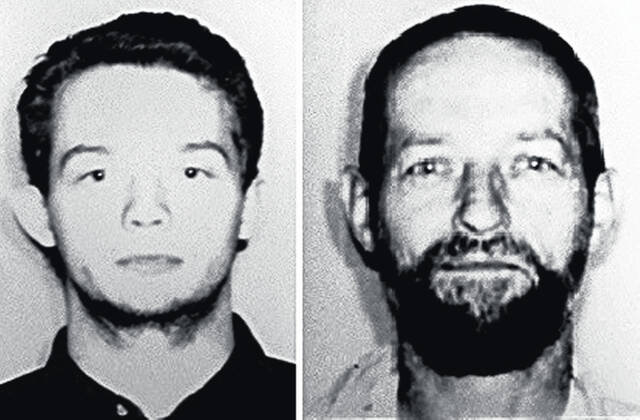Editor’s note — This is the first installment of a series on the incident which put Wilmington and the surrounding area in the national spotlight beginning on Feb. 15, 1997.
In 1997, Wilmington was a different place than it is now.
It was rated one of the top communities in the country. Airborne was humming, Nick Eveland was mayor, Bill Peelle was prosecuting attorney, and Bill McCracken was common pleas court judge. Wilmington was a place where you didn’t have to lock your doors and was known for its friendly ways.
On Feb. 15 of that year, Wilmington changed forever.
The day started out like any other for most. It was a Saturday and people were out and about running errands, getting lunch, going to sporting events, and doing their household chores.
Then, at approximately 1:30 p.m., Wilmington was turned upside-down.
‘Routine’ stop
It all started when Harold Harker, an Ohio State Highway patrolman, noticed a blue Chevrolet Suburban going too slow and displaying expired tags. He decided to pull the vehicle over and proceed with what he thought was going to be a routine traffic stop.
Little did he know at the time that this traffic stop would be anything but routine, and it would change his life and so many other lives throughout Clinton County.
Harker had pulled the Suburban over on the west side of town on Wayne Road where Bob Gates, Clinton County sheriff’s deputy, happened to be driving by on the way to a call. Gates decided to assist Harker with the traffic stop.
Harker exited his patrol car and approached the driver side of the stopped vehicle where he saw two men inside. After neither of the men could produce an ID, Harker asked the driver to exit the vehicle to be searched. After seeing that the driver was being uncooperative, Gates exited his patrol car to assist.
Then, the driver of the Suburban fled back to the vehicle as the passenger flung open his door. What ensued next ended up becoming some of the most dramatic police video in the history of dashboard cameras.
The shootout
The story above is the preface to what is now known as the Kehoe Shootout. The two men in the blue Suburban were Chevie and Cheyne Kehoe. They had been camping at Lake Hill Campground in Ross County and were traveling through Wilmington the day their expired Washington State tags prompted Harker to pull them over.
The moments that followed made this traffic stop anything but routine. As the driver, Chevie, ran from the officers back to his vehicle, a struggle ensued and the passenger, Cheyne, got out and began firing a gun at the officers. Several rounds were exchanged between the brothers and officers in the dramatic 27 seconds that changed Wilmington.
Cheyne fled on foot while Chevie jumped into the Suburban and sped off. A short while later Chevie was caught up with, near Clinton Electrical and Plumbing Supply, where more shots were exchanged with Wilmington police. He fled on foot and the brothers would not see each other for some time.
They were now on the run with their whereabouts unknown to local law enforcement.
Clinton County the had one of the largest manhunts in history on its hands. The Kehoe brothers were at-large, armed, and considered extremely dangerous. Wilmington police, the Clinton County Sheriff’s Office, and the Ohio State Highway Patrol used all of their resources to start tracking the shooters.
Who were they?
However, they faced an obstacle, because at the time they still didn’t know who these men were. All they had to go on was the blue Suburban, an expired Washington license plate, and what they were wearing.
Many questions had to be answered. Was the car stolen? Was it borrowed? Would the plates match up to who was doing the shooting? Those questions were at the front of the thoughts of everyone involved.
Clinton County and the shoot out were being picked up by the local news stations. They knew something big had happened, they just didn’t know what until they traveled to Wilmington.
The Wilmington News Journal’s Gary Huffenberger wasn’t on duty that day, but reporter Jay Carey was. According to first-hand accounts, Huffenberger received a phone call saying there was breaking news and they needed him to cover it.
Huffenberger, at the time, knew something big had happened, but had no idea how large the story would become. Jeff Hibbs was the editor then and law enforcement called a press conference to tell the public what had happened.
By that time, Cincinnati and Dayton news outlets had picked up on the shootout and were driving as fast as they could to Wilmington to cover the press conference — and maybe learn who had done the shooting.
We need to remember that at that time, communication was very different. Cell phones weren’t in everyone’s hands, social media wasn’t even a thought, and information couldn’t be sent immediately.
Uneasiness
Many people in Clinton County were uneasy that night and many locked their doors for the first time. Many farmers didn’t know if they would go into their barns in the morning to find two sleeping men or, worse, be taken hostage. It was a scary time in Clinton County.
Weeks went by without word on the two men. The question on everybody’s mind was where and when the Kehoes would be caught.
To be continued …
Jonathan McKay is a Clinton County native and a current member of Wilmington City Council.





